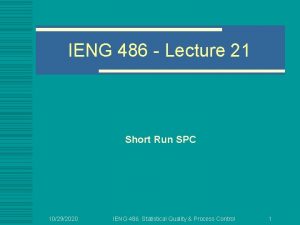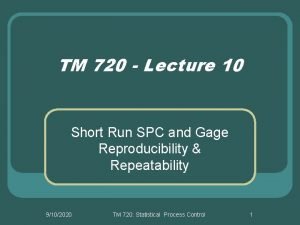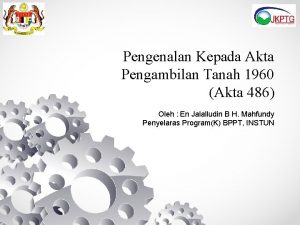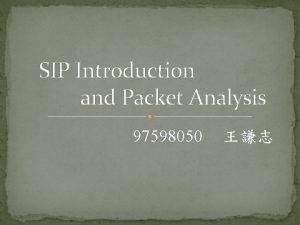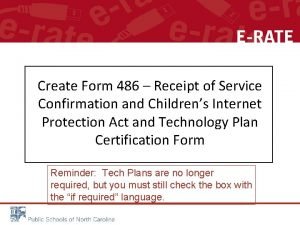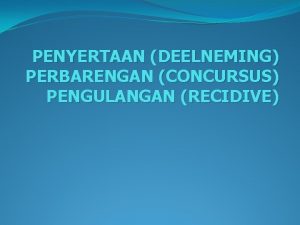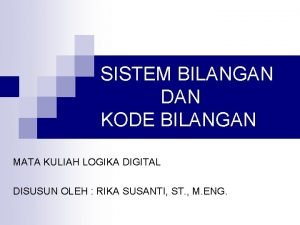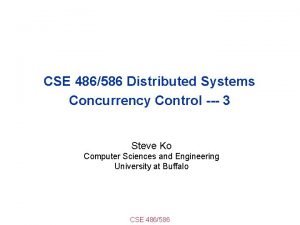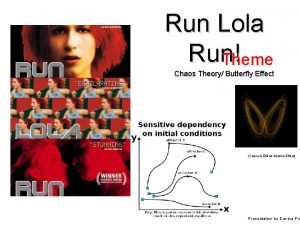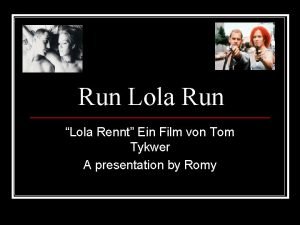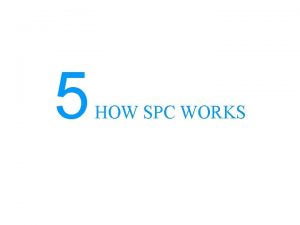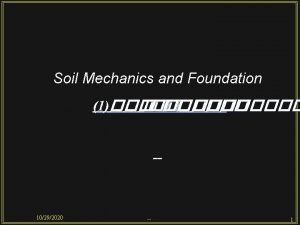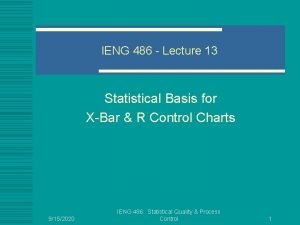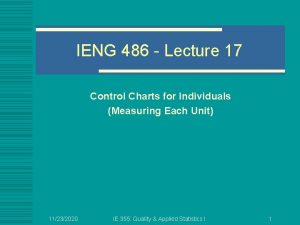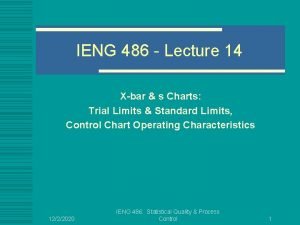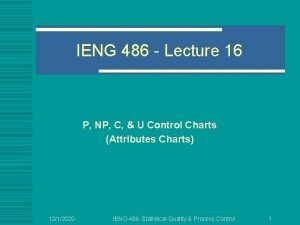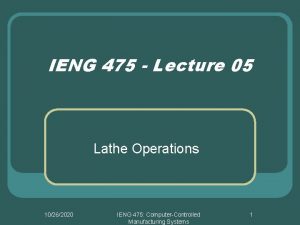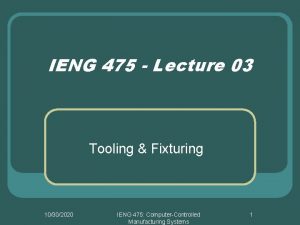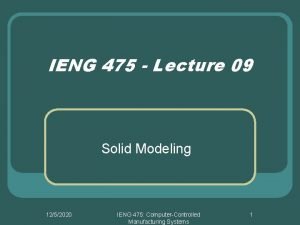IENG 486 Lecture 21 Short Run SPC 10292020





















- Slides: 21

IENG 486 - Lecture 21 Short Run SPC 10/29/2020 IENG 486 Statistical Quality & Process Control 1

Assignment w Reading: n Chapter 6 l n Section 6. 4: pp. 259 - 265 Chapter 9 l l l Sections 9. 1 – 9. 1. 5: pp. 399 - 410 Sections 9. 2 – 9. 2. 4: pp. 419 - 425 Sections 9. 3: pp. 428 - 430 w Homework: n CH 9 Textbook Problems: l 10/29/2020 1 a, 17, 26 Hint: Use Excel charts! IENG 486 Statistical Quality & Process Control 2

Review w Shewhart Control charts n Are for sample data from an approximate Normal distribution l Three lines appear on all Shewhart Control Charts w UCL, LCL l Two charts are used: w X-bar for testing for change in location w R or s-chart for testing for change in spread l We check the charts using 4 Western Electric rules w Attributes Control charts n Are for Discrete distribution data l l 10/29/2020 Use p- and np-charts for tracking defective units Use c- and u-charts for tracking defects on units Use p- and u-charts for variable sample sizes Use np- and c-charts with constant sample sizes TM 720: Statistical Process Control 3

Short Run SPC w Many products are made in smaller quantities than are practical to control with traditional SPC n n n In order to have enough observations for statistical control to work, batches of parts may be grouped together onto a control chart This usually requires a transformation of the variable on the control chart, and a logical grouping of the part numbers (different parts) to be plotted. A single chart or set of charts may cover several different part types 10/29/2020 TM 720: Statistical Process Control 4

DNOM Charts w Deviation from Nominal n Variable computed is the difference between the measured part and the target dimension where: 10/29/2020 Mi is the measured value of the ith part Tp is the target dimension for all of part number p TM 720: Statistical Process Control 5

DNOM Charts w The computed variable (xi) is part of a sub-sample of size n n n xi is normally distributed n is held constant for all part numbers in the chart group. w Charted variables are x and R, just as in a traditional Shewhart control chart, and control limits are computed as such, too: 10/29/2020 TM 720: Statistical Process Control 6

DNOM Charts w Usage: n n n A vertical dashed line is used to mark the charts at the point at which the part numbers change from one part type to the next in the group The variation among each of the part types in the group should be similar (hypothesis test!) Often times, the Tp is the nominal target value for the process for that part type l l 10/29/2020 Allows the use of the chart when only a single-sided specification is given If no target value is specified, the historical average (x) may be used in its’ place TM 720: Statistical Process Control 7

Standardized Control Charts w If the variation among the part types within a logical group are not similar, the variable may be standardized n This is similar to the way that we converted from any normally distributed variable to a standard normal distribution: l 10/29/2020 Express the measured variable in terms of how many units of spread it is away from the central location of the distribution TM 720: Statistical Process Control 8

Standardized Charts – x and R w Standardized Range: n Plotted variable is where: 10/29/2020 Ri is the range of measured values for the ith sub-sample of this part type j Rj is the average range for this jth part type TM 720: Statistical Process Control 9

Standardized Charts – x and R w Standardized x: n Plotted variable for the sample is where: 10/29/2020 Mi is the mean of the original measured values for this sub-sample of the current part type (j) Tj is the target or nominal value for this jth part type TM 720: Statistical Process Control 10

Standardized Charts – x and R w Usage: n Two options for finding Rj: l l n Prior History Estimate from target σ: Examples: l l 10/29/2020 Parts from same machine with similar dimensions Part families – similar part tolerances from similar setups and equipment TM 720: Statistical Process Control 11

Standardized Charts – Attributes w Standardized zi for Proportion Defective: n Plotted variable is n Control Limits: 10/29/2020 TM 720: Statistical Process Control 12

Standardized Charts – Attributes w Standardized zi for Number Defective: n Plotted variable is n Control Limits: 10/29/2020 TM 720: Statistical Process Control 13

Standardized Charts – Attributes w Standardized zi for Count of Defects: n Plotted variable is n Control Limits: 10/29/2020 TM 720: Statistical Process Control 14

Standardized Charts – Attributes w Standardized zi for Defects per Inspection Unit: n Plotted variable is n Control Limits: 10/29/2020 TM 720: Statistical Process Control 15

Guidelines for Implementing Control Charts 1. Determine which process or product characteristic(s) to control 2. Determine where the charts should be implemented in process 3. Choose proper type of control charts 4. Decide what actions should be taken to improve processes 5. Select data-collection systems and computer software 10/29/2020 IENG 486 Statistical Quality & Process Control 16

Determine Which Characteristic to Control and Where to Put Charts 1. 2. 3. 4. To start, apply charts to any process or product characteristics believed important. Charts found unnecessary are removed; others that may be required are added. (Usually more charts to start than after process has stabilized) Keep current records of all charts in use, i. e. , types and parameters of each. If charts used effectively number of charts for variables increases and number of attributes charts decreases 10/29/2020 IENG 486 Statistical Quality & Process Control 17

Determine Which Characteristic to Control and Where to Put Charts 5. 6. At beginning, use more attributes charts applied to finished units, i. e. , near end of process. As more is learned about the process, these are replaced with variables charts earlier in process on critical process characteristics that affect nonconformities. Rule of thumb: the earlier in the process that control can be established, the better. Control charts are an on-line process monitoring procedure; Maintain charts as close to work center as possible. Operators and process engineers should be directly responsible for using, maintaining and interpreting charts 10/29/2020 IENG 486 Statistical Quality & Process Control 18

Choosing Proper Type of Control Chart: Variables Charts w Use (x & R) or (x & S) charts when: 1. 2. 3. 4. 5. 6. 7. 8. 10/29/2020 New process or product coming online Chronically troubled process Wish to reduce downstream acceptance sampling Using attributes charts but yield still unacceptable Very tight specifications Operator decides whether or not to adjust process Change in product specs desired Process capability (stability) must be continually demonstrated IENG 486 Statistical Quality & Process Control 19

Choosing Proper Type of Control Chart: Attributes Charts w Use p, np, c or u charts when: 1. 2. 3. 4. 10/29/2020 Operators control assignable causes and it is necessary to reduce fallout Process is complex assembly operation and product quality measured in terms of occurrence of nonconformities: e. g. computers, automobiles Measurement data cannot be obtained Historical summary of process performance is necessary. Attributes charts are effective for summarizing a process for management IENG 486 Statistical Quality & Process Control 20

Choosing Proper Type of Control Chart: Individuals Charts § Use (x & MR), MA, EWMA, or CUSUM charts when: 1. 2. 3. 4. 10/29/2020 Repeated measures do not make sense Inconvenient / impossible to obtain more than one measurement per sample Automated testing allows you to measure every unit (EWMA chart may be best) Data becomes available very slowly and waiting for a larger sample is impractical. IENG 486 Statistical Quality & Process Control 21
 Tall + short h
Tall + short h Short run spc
Short run spc 5 letter words with i e n g
5 letter words with i e n g Reproducibility vs repeatability
Reproducibility vs repeatability Short run vs long run economics
Short run vs long run economics Short run equilibrium under perfect competition
Short run equilibrium under perfect competition Perfect competition long run equilibrium
Perfect competition long run equilibrium Proses pengambilan tanah
Proses pengambilan tanah Sip call flow
Sip call flow Form 486
Form 486 Classical encryption techniques in network security
Classical encryption techniques in network security Comm 486
Comm 486 Cs 486
Cs 486 876x8
876x8 Cse 486
Cse 486 486 means
486 means Perbedaan deelneming dan concursus
Perbedaan deelneming dan concursus Nilai bilangan 4 pada bilangan oktal 486 adalah
Nilai bilangan 4 pada bilangan oktal 486 adalah Cse 486
Cse 486 01:640:244 lecture notes - lecture 15: plat, idah, farad
01:640:244 lecture notes - lecture 15: plat, idah, farad Run lola run butterfly effect
Run lola run butterfly effect Nnlolas
Nnlolas

